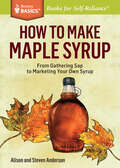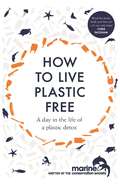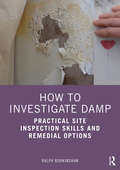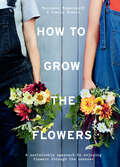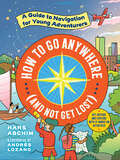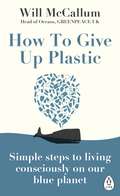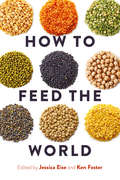- Table View
- List View
How to Make Money by Fast Trading: A Guide to Success (Perspectives In Business Culture Ser.)
by Renato Di LorenzoAll over the world a growing number of people are viewing trading the markets as a valuable source of additional income or even as a new career option. Sitting in front of a PC, they are able to connect to their broker’s trading platform and buy or sell on the world market assets of all kinds: gold, oil, shares, bonds, and so forth. Today, it is no longer a problem to “be short” on almost any class of asset. This book is an ideal guide on how to make money by fast trading. It will be especially valuable for those wishing to trade in their spare time with a limited amount of capital. Different styles of trading, including scalping, day trading, and swing trading, are clearly described, with advice on how to avoid common mistakes. In addition, the “Donkey” trading system – a system designed for everybody – is fully explained. Using this book, the reader will learn how to manage risk safely, maximizing the likelihood of success.
How to Make Maple Syrup: From Gathering Sap to Marketing Your Own Syrup. A Storey BASICS® Title (Storey Basics)
by Alison Anderson Steven AndersonFrom managing a sugar bush to slathering your pancakes, this Storey BASICS® guide covers everything you need to know to make and enjoy your own maple syrup.
How to Make Great Music Mashups: The Start-to-Finish Guide to Making Mashups with Ableton Live
by Paul ZalaWritten for the beginner DJ, this accessible book presents everything you need to know in order to create great dance floor moments that will take your sets to the next level and get you noticed as a DJ. Using Ableton’s industry-leading digital audio workstation, the reader will learn to achieve a professional sound by expertly manipulating Warping, pitching, editing, automation and plugin effects processing; also, avoiding mistakes such as key-clashing, jarring transitions, mismatched energies and more. The book’s companion website includes key-charts, musical scale diagrams, organisational templates for live sessions, and follow-along video demonstrations.
How to Make Great Music Mashups: The Start-to-Finish Guide to Making Mashups with Ableton Live
by Paul ZalaWritten for the beginner DJ, this accessible book presents everything you need to know in order to create great dance floor moments that will take your sets to the next level and get you noticed as a DJ. Using Ableton’s industry-leading digital audio workstation, the reader will learn to achieve a professional sound by expertly manipulating Warping, pitching, editing, automation and plugin effects processing; also, avoiding mistakes such as key-clashing, jarring transitions, mismatched energies and more. The book’s companion website includes key-charts, musical scale diagrams, organisational templates for live sessions, and follow-along video demonstrations.
How to Make and Use Compost: The practical guide for home, schools and communities
by Nicky ScottThe world of compost and how it relates to healthy soil is a fascinating, complex story. Compost helps to create and maintain healthy soil – the foundation of growing organically. It is also cost-saving, easy and fun, and a fantastic way to learn and connect with nature. Most importantly, composting is really beneficial for the environment as it massively reduces the amount of noxious methane gas generated from burying food waste in landfill. In How to Make and Use Compost, composting expert Nicky Scott reveals why making compost is so important for healthy soil and the environment, how it works and how to make your own compost. He provides clear guidance on the most appropriate system for your site, whether you're composting in a garden or a kitchen, and explains how different composting systems work, including cold composting, wormeries, bokashi and hot boxes. This practical book features an A-Z guide to what you can and cannot compost, composting techniques, common problems and their solutions – from Activators to fertilise the soil with microbial food sources, to Z for Zoo poo if you're lucky enough to live near a wildlife sanctuary! It also details how to compost food waste on a large scale for hotels, restaurants, cafés and other establishments, and shows you how to plan a school or community compost scheme. An extensive list of resources, including websites, organisations, books and where to buy equipment, is also included. Beautifully illustrated with photographs throughout, this handy guide is ideal for gardeners as well as those who want to become more sustainable.
How to Make a Spaceship: A Band of Renegades, an Epic Race and the Birth of Private Space Flight
by Julian Guthrie Sir Richard BransonAfterword by Professor Stephen Hawking"Reads like a thriller - and reveals many secrets... one of the great entrepreneurial stories of our time" (Washington Post)From the age of eight, when he watched Apollo 11 land on the Moon, Peter Diamandis's singular goal was to get to space. When he realized NASA was winding down manned space flight, he set out on one of the great entrepreneurial adventure stories of our time. If the government wouldn't send him to space, he would create a private space flight industry himself. In the 1990s, this idea was the stuff of science fiction. Undaunted, Diamandis found inspiration in the golden age of aviation. He discovered that Charles Lindbergh made his transatlantic flight to win a $25,000 prize. The flight made Lindbergh the most famous man on earth and galvanized the airline industry. Why, Diamandis thought, couldn't the same be done for space flight? The story of the bullet-shaped SpaceShipOne, and the other teams in the hunt for a $10 million prize is an extraordinary tale of making the impossible possible. In the end, as Diamandis dreamed, the result wasn't just a victory for one team; it was the foundation for a new industry.
How to Live Plastic Free: a day in the life of a plastic detox
by Luca Bonaccorsi Marine Conservation SocietyThank you for choosing this book - it shows that you care about the future of our planet.Whether you decide to go plastic free for an hour, a day or a year, this book will equip you with little steps we can each take to make a big difference.Let's turn the tide on plastic now - our oceans will thank you for it.Choking. Starving. Poisoning. This is what plastic litter is doing to marine life. Our oceans are, quite simply, facing environmental disaster. Yet by taking some simple steps and making a few changes to your daily routine, you can help to change this.How to Live Plastic Free will teach you everything you need to know about reducing your plastic usage on a daily basis. The chapters start with a typical morning routine and take you through your day, giving you tips and practical advice for removing unnecessary plastic at every possible opportunity.From the moment you wake up to the time you go to bed, you will learn how easy it can be to use plastic-free cosmetics, how to have plastic-free mealtimes, how to change your shopping habits and how to consider your use of plastic items at work. These simple, practical methods will show that small changes to your lifestyle can make a huge change to the future of our planet.
How to Lie with Maps, Third Edition
by Mark MonmonierAn instant classic when first published in 1991, How to Lie with Maps revealed how the choices mapmakers make—consciously or unconsciously—mean that every map inevitably presents only one of many possible stories about the places it depicts. The principles Mark Monmonier outlined back then remain true today, despite significant technological changes in the making and use of maps. The introduction and spread of digital maps and mapping software, however, have added new wrinkles to the ever-evolving landscape of modern mapmaking. Fully updated for the digital age, this new edition of How to Lie with Maps examines the myriad ways that technology offers new opportunities for cartographic mischief, deception, and propaganda. While retaining the same brevity, range, and humor as its predecessors, this third edition includes significant updates throughout as well as new chapters on image maps, prohibitive cartography, and online maps. It also includes an expanded section of color images and an updated list of sources for further reading.
How to Lie with Maps, Third Edition
by Mark MonmonierAn instant classic when first published in 1991, How to Lie with Maps revealed how the choices mapmakers make—consciously or unconsciously—mean that every map inevitably presents only one of many possible stories about the places it depicts. The principles Mark Monmonier outlined back then remain true today, despite significant technological changes in the making and use of maps. The introduction and spread of digital maps and mapping software, however, have added new wrinkles to the ever-evolving landscape of modern mapmaking. Fully updated for the digital age, this new edition of How to Lie with Maps examines the myriad ways that technology offers new opportunities for cartographic mischief, deception, and propaganda. While retaining the same brevity, range, and humor as its predecessors, this third edition includes significant updates throughout as well as new chapters on image maps, prohibitive cartography, and online maps. It also includes an expanded section of color images and an updated list of sources for further reading.
How to Lie with Maps, Third Edition
by Mark MonmonierAn instant classic when first published in 1991, How to Lie with Maps revealed how the choices mapmakers make—consciously or unconsciously—mean that every map inevitably presents only one of many possible stories about the places it depicts. The principles Mark Monmonier outlined back then remain true today, despite significant technological changes in the making and use of maps. The introduction and spread of digital maps and mapping software, however, have added new wrinkles to the ever-evolving landscape of modern mapmaking. Fully updated for the digital age, this new edition of How to Lie with Maps examines the myriad ways that technology offers new opportunities for cartographic mischief, deception, and propaganda. While retaining the same brevity, range, and humor as its predecessors, this third edition includes significant updates throughout as well as new chapters on image maps, prohibitive cartography, and online maps. It also includes an expanded section of color images and an updated list of sources for further reading.
How to Lie with Maps, Third Edition
by Mark MonmonierAn instant classic when first published in 1991, How to Lie with Maps revealed how the choices mapmakers make—consciously or unconsciously—mean that every map inevitably presents only one of many possible stories about the places it depicts. The principles Mark Monmonier outlined back then remain true today, despite significant technological changes in the making and use of maps. The introduction and spread of digital maps and mapping software, however, have added new wrinkles to the ever-evolving landscape of modern mapmaking. Fully updated for the digital age, this new edition of How to Lie with Maps examines the myriad ways that technology offers new opportunities for cartographic mischief, deception, and propaganda. While retaining the same brevity, range, and humor as its predecessors, this third edition includes significant updates throughout as well as new chapters on image maps, prohibitive cartography, and online maps. It also includes an expanded section of color images and an updated list of sources for further reading.
How to Investigate Damp: Practical Site Inspection Skills and Remedial Options
by Ralph BurkinshawThe aim of this book is to take the reader by the hand and show them exactly how to carry out various inspection techniques to identify the causes of damp in buildings. This is achieved by taking them through a variety of investigation methods using real-life case studies illustrated by dozens of sketches, drawings and photographs – and considerable insight into how investigations can be conducted on site – and also including most importantly the Client’s input and perspective on a damp issue. Written in non-technical language by a leading expert and author on damp, the book begins by outlining the common types and phases of an investigation, the equipment required and the nature of potential remedial work. Case studies then cover condensation, penetrating damp, plumbing and roof leaks, below ground moisture and damp bridging – and some innovative remedies installed by the author himself. The final section contains step by step guidance on procedures such as using a humidity box, inspecting a cavity wall, using a damp meter and extracting and testing a plaster sample for salt content. The book is full of hints and tips developed over a career spent investigating, diagnosing and remediating damp issues and is essential reading for surveyors looking to improve their skills and knowledge of this often complex defect. The book will also be very useful for homeowners trying to self-diagnose, and architects, engineers and other professionals who need to gain insight into common problem caused by moisture imbalance in buildings.
How to Investigate Damp: Practical Site Inspection Skills and Remedial Options
by Ralph BurkinshawThe aim of this book is to take the reader by the hand and show them exactly how to carry out various inspection techniques to identify the causes of damp in buildings. This is achieved by taking them through a variety of investigation methods using real-life case studies illustrated by dozens of sketches, drawings and photographs – and considerable insight into how investigations can be conducted on site – and also including most importantly the Client’s input and perspective on a damp issue. Written in non-technical language by a leading expert and author on damp, the book begins by outlining the common types and phases of an investigation, the equipment required and the nature of potential remedial work. Case studies then cover condensation, penetrating damp, plumbing and roof leaks, below ground moisture and damp bridging – and some innovative remedies installed by the author himself. The final section contains step by step guidance on procedures such as using a humidity box, inspecting a cavity wall, using a damp meter and extracting and testing a plaster sample for salt content. The book is full of hints and tips developed over a career spent investigating, diagnosing and remediating damp issues and is essential reading for surveyors looking to improve their skills and knowledge of this often complex defect. The book will also be very useful for homeowners trying to self-diagnose, and architects, engineers and other professionals who need to gain insight into common problem caused by moisture imbalance in buildings.
How to Grow the Flowers: A Sustainable Approach To Enjoying Flowers Through The Seasons
by Camila Romain Marianne MogendorffGrowing flowers to cut and enjoy at home can sharpen our awareness of the world around us and make us more attuned to nature. We find it impossible to walk anywhere without spotting a prized rose in a front garden, a brassica gone to seed on a neighbouring allotment plot or a weedy verge in a carpark and considering its potential for cutting.
How to Go Anywhere (and Not Get Lost): A Guide to Navigation for Young Adventurers
by Hans AschimA fun, fully illustrated history of navigation, from the earliest Polynesian star navigators to modern-day GPS - complete with hands-on activities to demonstrate the various tools and techniques.
How to Give Up Plastic: A Guide to Changing the World, One Plastic Bottle at a Time. From the Head of Oceans at Greenpeace and spokesperson for their anti-plastic campaign
by Will McCallum'We have a responsibility, every one of us' David Attenborough Around 12.7 million tonnes of plastic are entering the ocean every year, killing over 1 million seabirds and 100,000 marine mammals.By 2050 there could be more plastic in the ocean than fish by weight.Plastic pollution is the environmental scourge of our age, but how can YOU make a difference? This accessible guide, written by the campaigner at the forefront of the anti-plastic movement, will help you make the small changes that make a big difference, from buying a reusable coffee cup to running a clean-up at your local park or beach. Tips on giving up plastic include:· Washing your clothes within a wash bag to catch plastic microfibers (the cause of 30% of plastic pollution in the ocean)· Replacing your regular shampoo with bar shampoo· How to lobby your supermarket to remove unnecessary packaging · How to throw a plastic-free birthday party· How to convince others to join you in giving up plasticPlastic is not going away without a fight. We need a movement made up of billions of individual acts, bringing people together from all backgrounds and all cultures, the ripples of which will be felt from the smallest village to the tallest skyscrapers. This is a call to arms - to join forces across the world and to end our dependence on plastic. #BreakFreeFromPlasticPlastic is not going away without a fight. We need a movement made up of billions of individual acts, bringing people together from all backgrounds and all cultures, the ripples of which will be felt from the smallest village to the tallest skyscrapers.'Plastic waste is one of the greatest environmental challenges facing the world' Theresa May
How to Gain Gain: A Reference Book on Triodes in Audio Pre-Amps
by Burkhard VogelThe 34 chapters of the 2nd edition of How to Gain Gain give a detailed insight into a collection (54) of the most common gain producing, constant current generating possibilities, and electronic noise creation of triodes for audio pre-amplifier purposes. These chapters also offer complete sets of formulae to calculate gain, frequency and phase responses, and signal-to-noise ratios of certain building blocks built-up with this type of vacuum valve (tube). In all cases detailed derivations of the gain formulae are also presented. All what is needed are the data sheet valve characteristic figures of the triode's mutual conductance, the gain factor and the internal plate (anode) resistance. To calculate frequency and phase responses of gain stages the different data sheet based input and output capacitances have to be taken into account too. To calculate transfer functions and signal-to-noise ratios for any kind of triode driven gain stage, including all its bias setting, frequency, phase, and electronic noise influencing components, example Mathcad 11 worksheets as an essential simulation tool for each chapter allow easy follow-up and application of the respective formulae. Free download of all worksheets is guaranteed from the editor's web-site.
How to gain gain: A Reference Book on Triodes in Audio Pre-Amps
by Burkhard VogelThe 17 chapters of "How to Gain Gain" give a detailed insight into a collection of the most common gain producing and constant current generating possibilities (28) of triodes for audio pre-amplifier purposes. These chapters also offer complete sets of formulae to calculate gain, frequency and phase responses of certain building blocks built-up with this type of vacuum valve (tube). In all cases detailed derivations of the gain formulae were also presented. All what is needed are the data sheet valve characteristic figures of the triode's mutual conductance, the gain factor and the internal plate (anode) resistance. To calculate frequency and phase responses of gain stages the different data sheet based input and output capacitances have to be taken into account as well. To calculate transfer functions for any kind of triode driven gain stage, including all its bias setting, frequency and phase influencing components, example MathCad worksheets as a second part of each chapter allow easy follow-up and application of the respective formulae. In addition, to demonstrate the differences of feedback and non-feedback relationships, in the last chapter and on MathCad basis, a very extensive and complete calculation example for a three stage linear pre-amplifier as well as a three stage RIAA equalized phono amplifier plays the wind up role of the book.
How to Find a Job and Keep It
by Simon BoyleLooking for a job? Don’t know where to start? This friendly book is here to help you. Learn how to:· Write a CV and covering letter· Contact employers and recruitment agencies· Manage your personal finances· Act professionally in a work environment And most important of all:· Find a job you love, and keep it! So why not open it now and get going?
How to Finance Energy Management Projects: Solving the "Lack of Capital Problem"
by Eric A. Woodroof Albert ThumannThe landscape for implementing energy efficient projects is rapidly changing and the need for energy project financing has never been greater. This book provides the key success factors for structuring a finance energy project and getting it approved by top management. Part I covers the need for financing as well as the basic concepts. Part II covers some practical applications of financing such as performance contracts, power purchase agreements and other items like PACE financing. Part III contains articles that have helped many engineers get more projects implemented as they include information that can be used to present projects and get them approved.
How to Feed the World
by Jessica Eise and Kenneth Alan FosterBy 2050, we will have ten billion mouths to feed in a world profoundly altered by environmental change. How can we meet this challenge? In How to Feed the World, a diverse group of experts from Purdue University break down this crucial question by tackling big issues one-by-one. Covering population, water, land, climate change, technology, food systems, trade, food waste and loss, health, social buy-in, communication, and, lastly, the ultimate challenge of achieving equal access to food, the book reveals a complex web of factors that must be addressed in order to reach global food security. How to Feed the World unites contributors from different perspectives and academic disciplines, ranging from agronomy and hydrology to agricultural economy and communication. Hailing from Germany, the Philippines, the U.S., Ecuador, and beyond, the contributors weave their own life experiences into their chapters, connecting global issues to our tangible, day-to-day existence. Across every chapter, a similar theme emerges: these are not simple problems, yet we can overcome them. Doing so will require cooperation between farmers, scientists, policy makers, consumers, and many others. The resulting collection is an accessible but wide-ranging look at the modern food system. Readers will not only get a solid grounding in key issues, but be challenged to investigate further and contribute to the paramount effort to feed the world.
How to Estimate with RSMeans Data: Basic Skills for Building Construction (Rsmeans Ser. #64)
by Saleh A. Mubarak RSMeansUsing North America's most recognized construction cost data from RSMeans, this step-by-step guide develops problem-solving skills through over 300 sample problems and exercises. All of the major construction items, including site work, concrete and masonry, wood and metal framing, doors and windows, and more are covered. Access to a password-protected web site is included, which contains the instruction version of RSMeans Cos/Works, the electronic version of RS Means Building Construction Cost Data, and sample building plans and spreadsheets, enabling you to practice creating a complete construction estimate.
How to Estimate with RSMeans Data: Basic Skills for Building Construction
by Saleh A. Mubarak RSMeansUsing North America's most recognized construction cost data from RSMeans, this step-by-step guide develops problem-solving skills through over 300 sample problems and exercises. All of the major construction items, including site work, concrete and masonry, wood and metal framing, doors and windows, and more are covered. Access to a password-protected web site is included, which contains the instruction version of RSMeans Cos/Works, the electronic version of RS Means Building Construction Cost Data, and sample building plans and spreadsheets, enabling you to practice creating a complete construction estimate.
How to Estimate with RSMeans Data: Basic Skills for Building Construction (RSMeans #64)
by RSMeans Saleh A. MubarakA practical, hands-on guide to real-world construction estimating How to Estimate with RSMeans Data is the only instructional book on construction cost estimating that uses the most popular source of construction cost data, RS Means. This updated fifth edition includes new coverage on the role of Building Information Modeling (BIM) in the estimating process, and over 300 sample problems and exercises that show you how to apply cost data to your building project based on the RS Means 2015 Building Construction Cost Data. The companion website provides access to RS Means CostWorks data, allowing you to use real-world numbers in your practice estimates, and the included Instructor's Manual provides step-by-step solutions to problems in the book. Focused on the practical aspects of estimating, this book emphasizes the application of estimating techniques—which are transferable to any estimating software—through problem solving and the ground-up creation of complete construction project estimates. Estimating skills are fundamental to the construction industry, and are applied by all parties at all levels throughout the industry. This book is a hands-on guide to the techniques and tools used to create a thorough estimate, with plenty of opportunities for practice. Apply cost data to all aspects of the building project Practice your skills on over 300 sample problems Construct a complete estimate using RSMeans Besides being an essential construction skill, learning estimating helps you become familiar with reading and understanding construction blueprints and how construction assemblies are built. Mastery of these vital skills is important to your future career, and How to Estimate with RSMeans Data is your ideal guide to a solid foundation.

